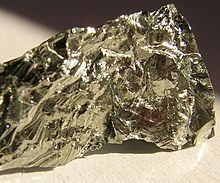Germanium Pípè / dʒ ər ˈ m eɪ n i ə m / (jər-MAY -nee-əm Ìhànsójú grayish white Ìwúwo átọ̀mù A r, std (Ge) 72.630(8) [ 1] Germanium ní orí tábìlì àyè
Nọ́mbà átọ̀mù (Z ) 32 Ẹgbẹ́ group 14 (carbon group) Àyè àyè 4 Àdìpọ̀ Àdìpọ̀-p Ẹ̀ka ẹ́límẹ́ntì Metalloid Ìtò ẹ̀lẹ́ktrọ́nù [Ar ] 3d10 4s2 4p2 Iye ẹ̀lẹ́ktrọ́nù lórí ìpele kọ̀ọ̀kan 2, 8, 18, 4 Àwọn ohun ìní ara Ìfarahàn at STP solid Ìgbà ìyọ́ 1211.40 K (938.25 °C, 1720.85 °F) Ígbà ìhó 3106 K (2833 °C, 5131 °F) Kíki (near r.t. ) 5.323 g/cm3 when liquid (at m.p. ) 5.60 g/cm3 Heat of fusion 36.94 kJ/mol Heat of 334 kJ/mol Molar heat capacity 23.222 J/(mol·K) pressure
P (Pa)
1
10
100
1 k
10 k
100 k
at T (K)
1644
1814
2023
2287
2633
3104
Atomic properties Oxidation states −4 [ 2] +2 +4 Àdàkọ:Infobox element/symbol-to-oxidation-state/comment Electronegativity Pauling scale: 2.01 Atomic radius empirical: 122 pm Covalent radius 122 pm Van der Waals radius 211 pm Color lines in a spectral range Spectral lines of germaniumOther properties Natural occurrence primordial Crystal structure Speed of sound thin rod 5400 m/s (at 20 °C) Thermal expansion 6.0 µm/(m·K) Thermal conductivity 60.2 W/(m·K) Electrical resistivity 1 Ω·m (at 20 °C) Magnetic ordering Diamagnetic [ 3] Young's modulus 103[ 4] Shear modulus 41[ 4] Bulk modulus 75[ 4] Poisson ratio 0.26[ 4] Mohs hardness 6.0 CAS Number 7440-56-4 Main isotopes of germanium
Àdàkọ:Category-inline references 


